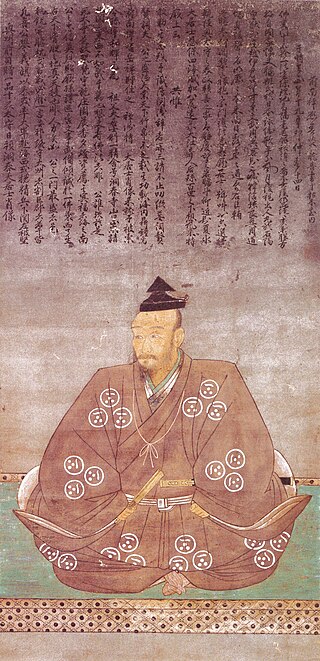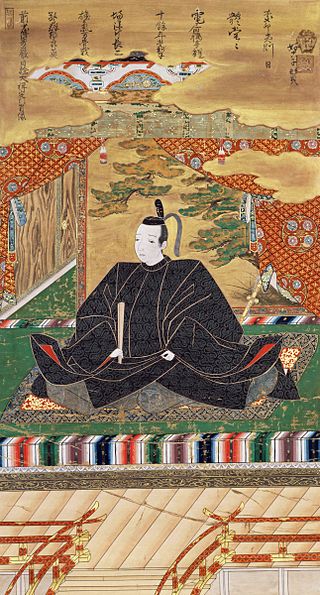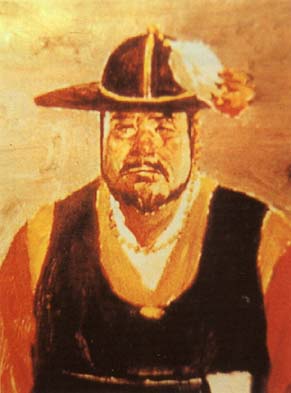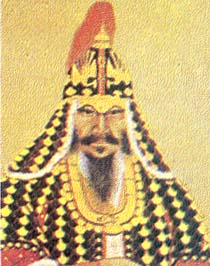
Yi Sun-sin was a Korean admiral and military general famed for his victories against the Japanese navy during the Imjin war in the Joseon Dynasty.

Mōri Motonari was a prominent daimyō in the western Chūgoku region of Japan during the Sengoku period of the 16th century. The Mōri clan claimed descent from Ōe no Hiromoto (大江広元), an adviser to Minamoto no Yoritomo. Motonari was called the "Beggar Prince". He was known as a great strategist who began as a small local warlord (jizamurai) of Aki Province and extended his clan's power to nearly all of the Chūgoku region through war, marriage, adoption and assassination.

North Jeolla Province, also known as Jeonbuk, is a province of South Korea in the Honam region in the southwest of the Korean Peninsula. North Jeolla borders the provinces of South Chungcheong to the north, North Gyeongsang and South Gyeongsang to the east and South Jeolla to the south. North Jeolla was established in 1896 from the northern part of the old Jeolla province, one of the Eight Provinces of Korea.
The Donghak Peasant Revolution (Korean: 동학농민혁명) was a peasant revolt that took place between 11 January 1894 and 25 December 1895 in the Korean state Joseon. The peasants were primarily followers of Donghak, a Neo-Confucian movement that rejected Western technology and ideals.

The Battle of Changsha of 1944 was an invasion of the Chinese province of Hunan by Japanese troops near the end of the Second Sino-Japanese War. As such, it encompasses three separate conflicts: an invasion of the city of Changsha and two invasions of Hengyang.

Kobayakawa Hideaki was the fifth son of Kinoshita Iesada and a nephew of Toyotomi Hideyoshi. He was gained the rank of Saemon no Kami (左衛門督) or in China Shikkingo (執金吾) at genpuku and held the court title of Chūnagon (中納言), Hideaki was also called Kingo Chūnagon (金吾中納言).

The Japanese invasions of Korea, commonly known as the Imjin War, involved two separate yet linked invasions: an initial invasion in 1592, a brief truce in 1596, and a second invasion in 1597. The conflict ended in 1598 with the withdrawal of Japanese forces from the Korean Peninsula after a military stalemate in Korea's southern provinces.

In the Battle of Myeongnyang, on October 26, 1597, the Korean Joseon Kingdom's navy, led by Admiral Yi Sun-sin, fought the Japanese navy in the Myeongnyang Strait, near Jindo Island, off the southwest corner of the Korean peninsula.
Righteous armies, sometimes called irregular armies or militias, were informal civilian militias that appeared several times in Korean history, when the national armies were in need of assistance.
The Joseon naval campaigns of 1592 were naval campaigns conducted by Korean admiral Yi Sun-sin during Japanese invasions of Korea (1592-1598) against the Japanese forces of Toyotomi Hideyoshi. These campaigns made Yi a legendary figure in Korean history on par with, if not surpassing, the great general Eulji Mundeok. The campaigns of Yi were vital in halting the Japanese invasion, which had the ultimate aim of conquering not just Korea, but Ming China as well. Yi was able to severely impair Japanese logistics and reinforcements for the land forces in Korea.

Won Gyun was a Korean general and admiral during the Joseon Dynasty. He is best known for his campaigns against the Japanese during Hideyoshi's invasions of Korea. Won was a member of Wonju Won clan, which was well known for its members' military accomplishments. He was born in 1540 near Pyeongtaek and demonstrated his skill as warrior at a young age. He was qualified as a military officer and was first assigned to the northern border to defend against the Jurchens, who frequently raided Korean villages. Won led many successful campaigns with Yi Il and Yi Sun-sin against the Jurchens. After considerable accomplishments on the northern frontier, he was promoted to admiral in 1592 and sent to the southern coast of Gyeongsang Province to command the province's Western Fleet, along with Yi Sun-sin, who became admiral before Won and took command of Jeolla Province's Eastern Fleet. At the time, Won and Yi were cavalry leaders who had no experience with naval warfare.

Gwon Yul was a Korean Army General and the Commander-in-chief of the Joseon Dynasty, who successfully led the Korean forces against Japan during the Japanese invasions of Korea. He is best known for the Battle of Haengju where he defeated an attacking force of about 30,000 Japanese with 2,800 troops.
The Battle of Jeonju was one of the first battles fought in Korea during the Japanese invasions of Korea (1592–1598).
Yi Gwang was a commander of Korean Joseon Dynasty forces throughout Toyotomi Hideyoshi's invasions of Korea at the end of the 16th century.

Kobayakawa Takakage was a samurai and daimyō during the Sengoku period and Azuchi–Momoyama period. He was the third son of Mōri Motonari who was adopted by the Kobayakawa clan and became its 14th clan head. He merged the two branches of the Kobayakawa, the Takehara-Kobayakawa clan (竹原小早川氏) and Numata-Kobayakawa clan (沼田小早川氏). He became an active commander of the Mōri army and he with his brother Kikkawa Motoharu became known as the “Mōri Ryōsen", or “Mōri's Two Rivers" (毛利両川). As head of the Kobayakawa clan, he expanded the clan's territory in the Chūgoku region, and fought for the Mōri clan in all their campaigns
The Battle of Byeokjegwan was a military engagement fought on 27 February 1593, between the armies of the Ming dynasty led by Li Rusong and Japanese forces under Kobayakawa Takakage. It resulted in a Japanese victory and Ming retreat.
Jeong Ki-ryong (1562–1622) was a prominent Korean Army general during the Joseon Dynasty. He fought against the Japanese invasions of Korea (1592–1598), and won the battles of Geochang and Geumsan. He was one of those who recaptured the Sangju castle, captured the Japancese general in Goryeong, and recaptured Seongju, Hapcheon, Uiryeong, Kyungju and Ulsan.
Ko Kyŏng-myŏng was a Joseon dynasty scholar and Yangban, who became a Righteous Army leader in the Imjin War. He was killed while attacking Geumsan in 1592.
Jo Heon was a Joseon official and militia leader in Korea at the time of the Imjin war. He believed that Japan under Toyotomi Hideyoshi posed a threat to Korean security, but his warnings were not heeded. When war broke out in 1592, he raised a volunteer militia to resist the Japanese invaders. He was killed during the second battle of Geumsan in 1592.
The Battle of Yongin was a battle that happened during the Japanese invasions of Korea. The battle was fought from June 5-6, 1592. Yi Gwang's force of 60,000 lost to the numerically inferior Japanese garrison of 1,600-1,900.









